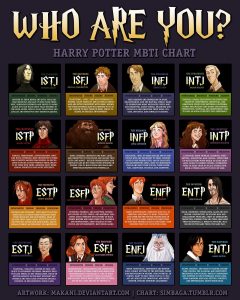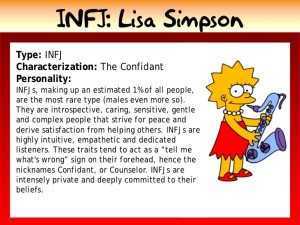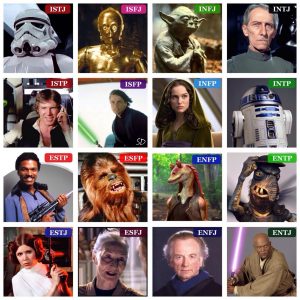6 Chapter 6: Applying the Myers-Briggs Type Indicator to Your Career Exploration Process
Chapter 6: Applying the Myers-Briggs Type Indicator to Your Career Exploration
Dr. Michael Duggan
Sonny: “Dreams die.”
Danny McGuire: “No, no, no, no! Not by themselves. We kill them!”
–Michael Beck & Gene Kelly, Xanadu [motion picture, 1980]
The Myers-Briggs Type Indicator
The Myers-Briggs Type Indicator (MBTI) is a test that is often used in helping people understand themselves better and find preferences. Based on the theories of Swiss psychologist Carl Jung in the 1800, Jung belived who had speculated that people experience the world using four principal psychological functions: specifically sensation, intuition, feeling, and thinking – He also believe that one of these four functions is dominant for a person most of the time (2017) [1]. Much of Jung’s work was to help his patients develop a better sense of their dominant psychological functions and then translating this insight to helping his clients develop different ways to approve their life situations.
Fast forward to the mid-1900’s. Katharine Cook Briggs and her daughter Isabel Briggs Myers first developed the test during World War II patterning it after psychologist Carl Jung’s theories of personality. The goal was to translate these principles into a more modern level of insight and then take this information in application to view a variety of topics in life. It has been refined several times through the years and is used in a variety of areas including leadership training, career exploration, relationship and marriage counseling, employee training, and for personal development.
The EU Myers Briggs Company state the MBTI is “one of the most widely used personality theory in history” [2]. Indeed, the MBTI is used in a variety of areas. From career exploration, to conflict management, to business practices, to many other areas, the MBTI is a widely relied upon tool for providing insight into ourselves and to provide direction for our futures.
Please make a note that the MBTI is designed to measure preferences for different personality types. That is, it directs us to see the way we prefer to do and view things, but we are always capable of looking or doing things another way as well. For example, first try writing your name with the hand you normally write with. Now, try writing your name with the opposite hand. Obviously, you are capable of doing so, but it feels a little different and perhaps a little less comfortable. This is because your preference for writing is your dominant hand—but this is in no way absolute.
What do we mean when we say “preferences”? A classic analogy frequently used is our handwriting. We each have a dominant hand we prefer to write with–be it right or left–and in most every situation, use that specific hand to write. Lets say I’m right-handed (which I am), my “preference” when it comes to writing is to then use my right hand. This is not to say I cannot use my left, but it certainly would not be my first choice and certainly not what I would identify as my strength!
Specifically, the MBTI examines four dimensions of personality and determines in each dimension which way we tend to prefer to interact with the world. Those four dimensions are:
- How we direct our energy
- How we gather information
- How we make decisions
- How we deal with the other world
For each dimension, we distinct each into two possibilities, and find people tend to lean towards one possibility or the other. Let’s look more closely at each of these:
How we direct or energy: Extroversion vs. Introversion
People who lean towards extroversion tend to focus on people and things on the outer world. People who lean towards introversion focus on the thoughts, feelings, and impressions of the inner world.
How we gather information: iNtution vs. Sensing
People who lean towards sensing tend to focus on facts and details that can be confirmed by experience. People who lean towards intuition focus on possibilities and relationships among ideas.
How we make decisions: Feeling vs. Thinking
People who lean towards thinking use impersonal, objective, logical analysis to reach conclusions. People who lean towards feeling tend to use person-centered, subjective analysis to reach conclusions.
How we deal with the other world: Perceiving vs. Judging
People who lean towards judging then to prefer to plan and organize themselves to make decisions and come to closure on decisions. People who lean towards perceiving on the other hand tend to be spontaneous and adaptable, collecting information and usually staying open to new options and ideas. It is important to note, “Judging” has nothing to do with the term “Judgemental”, rather we are using the term judging more in an evaluative respect.
A nice video summarizing these 8 different categories from Psych2Go is below:
When a person takes the MBTI they are given a “code” that tells a person what they lean towards for each of the four dimensions. For example, an “ENFP” would mean a person tends to identify with the MBTI descriptions of Extraversion, iNtuition, Feeling, and Perceiving. An “ISTJ” would mean a person tends to identify with the MBTI descriptions of Introversion, Sensing, Thinking, and Judging.
So why take this test for a class like ours? Research shows people with similar MBTI types tend to find high levels of satisfaction when they work in careers that match their personality type. When you get your results, you will receive an accompanying book, “Introduction to Type and Careers” that will explain this more in detail. Although you will most likely take this test in class, a more informal but free version can be found online at https://www.truity.com/test/type-finder-personality-test-new [3]
There are MANY videos out there on the MBTI and applying the results. A personal favorite of mine is written is done by Jean Kummerow as part of her TED talk at the link below:
Another fun thing to explore are the huge variety of websites dedicated to MBTI types and entertainment. For example, Harry Potter, the Simpsons, and even Star Wars:



I find the Myers-Briggs is helpful not only for career exploration, but all aspects of everyday life. That said, remember we again are only taking a piece of puzzle here, looking for themes between the MBTI, Strong Interest Inventory, and the other things that you learn from this textbook and class. None alone are the sole answer but rather, just another way to develop insight into the bigger picture. Now that we have a few puzzle pieces, lets start to do some research into specific careers looking for answers to the important questions–like career outlooks, hiring opportunities, and lengths of study to enter a different career fields.
- Huber D., Kaufmann H., Steinmann M. (2017) The Missing Link: The Innovation Gap. In: Bridging the Innovation Gap. Management for Professionals. Springer, Cham ↵
- "The History of the Myers-Briggs", The EU Myers-Briggs Company, access January 31, 2020 https://eu.themyersbriggs.com/en/tools/MBTI/Myers-Briggs-history ↵
- "Truity Test of Myers-Briggs", Truity, accessed January 31, 2020, https://www.truity.com/test/type-finder-personality-test-new ↵

